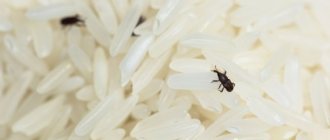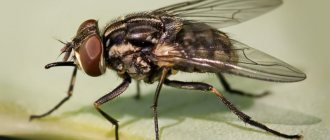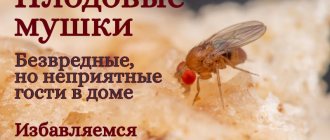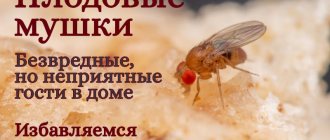Many people are prejudiced against any bugs in the apartment, knowingly considering them pests.
This approach is partly correct, because most types of insects living in the house most often cause some kind of damage, and sometimes even pose a threat to health. But some species enter a person’s home by accident and are absolutely not dangerous, and living in their usual environment - a garden or vegetable garden - they bring invaluable benefits.
The small light green midge, the lacewing, is one of these insects.
Description and appearance of the lacewing
Lacewings are a fairly large family of lacewing insects, numbering about 2,000 species. The most famous and widespread is the common lacewing. This is a green insect whose body size rarely exceeds 1 cm, and its wingspan reaches 1.5 - 3 cm.
The body is elongated, slightly curved downwards. The wings are large, elongated, oval, pale green, patterned. Because of their lacy transparent wings, green midges are also called fleurs (fleur is a translucent haze). A distinctive feature of insects is their large golden-bronze eyes. Because of them, the midge received its main name.
Lacewing
What are the stages of development
Among the main stages of development of this insect are:
- Egg. The female lays eggs in the early morning or late evening, during the cool period. She does this in an interesting way. First, it releases a thread of liquid, which hardens in air, and then attaches an egg to the top of this “stick.” The masonry takes on the shape of a “bush”. This method of laying is determined by the fact that the larvae do not all hatch at the same time, and individuals that emerged from the egg earlier can eat the newcomers.
- Larva. The lacewing larva is very voracious and omnivorous. During its development, it undergoes 2-3 moults before pupating. The larvae feed in a specific way; they make a puncture in the prey insect, inject a paralyzing substance into it, and then suck out the vital juices.
- Doll. After passing through three stages, the larva turns into a pupa. It can be located inside a rolled leaf, under it, under the bark of a tree. The cocoon is white.
Lacewing larvae are quite voracious
- Adult. Towards the end of its development, the formed insect in the cocoon begins to move, gnaws through it and gets out. To carry out the mating process, an adult needs to eat. The lacewing retains the ability to lay eggs throughout its entire life span after hatching from the cocoon.
The life cycle of development from egg to adult insect usually takes 2 months.
Insect lifestyle
Lacewings begin to be active at dusk, and during the day they most often hide from sunlight in secluded places - in crevices, under grass, on branches under the cover of foliage. Despite their large wings, midges do not fly very well and do not really like to do so. Most often, the lacewing rises into the air either to find food or if someone frightens it.
Habitat and optimal living conditions
Of the 2,000 species of green midges, approximately 70 live in Europe, the rest live in America and Asia. Small insects with light green transparent wings can be found in the garden, in the field and in the forest clearing. They prefer herbaceous plants, as they fly low and rarely reach the crown of a bush or tree.
Lacewings appear in the spring, when the temperature rises above +10⁰С. The most comfortable conditions for them are warm, windless weather, moderate humidity.
Reproduction and life cycle
The life cycle of the lacewing, like many other insects, consists of 4 stages. A larva emerges from the egg, undergoes 3 molts, pupates, and turns into an adult insect. Laying eggs is very interesting. The female releases a drop of viscous substance onto the surface of the leaf and then takes off, pulling it out. The resulting thread, 6–12 mm long, instantly hardens in air, and the lacewing attaches an egg to its upper end.
After 4–6 days, larvae emerge from the eggs. Their initial size is no more than 1 mm, but gradually they grow to 7–9 mm. Over the course of 2-3 weeks, the larva molts three times and then forms a cocoon. After 10–16 days, an adult lacewing emerges from the cocoon.
What does the lacewing eat at different stages of development?
The food preferences of insects change significantly during development. The larvae hatched from eggs have an excellent appetite and are predators. They are eating:
- aphids;
- scale insects;
- weevils;
- thrips;
- caterpillars;
- spider mites;
- whiteflies;
- mole cricket;
- mole;
- moths;
- insect eggs (including the Colorado potato beetle);
- spider cocoons.
The mouthparts of larvae are not designed for chewing food. The process of finding and eating prey does not look quite usual. The larva moves around the plant, shaking its head from side to side, as if groping for prey. As soon as its jaws touch an aphid or other insect, the larva grabs them and injects a caustic secretion into the body, which eats away all the insides in 1-2 minutes. After this, the future lacewing sucks up the resulting liquid.
Adults are herbivores. Their diet includes:
- flower nectar;
- honeydew;
- juice of some plants;
- honeydew.
Nutrition
Scientists believe that some species of small green midges retain their predatory habits as adults, and continue to hunt aphids, moths and other insect larvae.
Lifespan
Adult lacewings live approximately 25 – 35 days. The development process from the egg stage to the adult takes about another month. Over the course of a year, depending on the climatic characteristics of the region and weather conditions, from 3 to 5 generations of insects are born.
Natural enemies of the lacewing
In nature, the main enemies of the lacewing are ants. By attacking green midges, the ants protect the aphids, which secrete honeydew - their favorite delicacy. In addition, green midges can be threatened by some species of birds, insectivorous bats, and insect predators.
Reasons for the appearance of lacewings in an apartment
Human housing is not a natural habitat for the lacewing. There are several factors that attract insects to a house or apartment:
- warmth - when the outside temperature drops, green midges begin to look for a more comfortable shelter;
- light - like many other insects, lacewings fly to a source of bright light, which can be a lamp in an apartment;
- pests on indoor plants - moving in search of a suitable place to lay eggs, the female lacewing can choose one of the flowers standing on the windowsill or on the balcony if there are a lot of aphids or other parasites on it.
And finally, a lacewing may end up in an apartment by accident. It can be blown out of an open window by a gust of wind, carried on flowers, fruit or clothing by someone in the household, or carried on fur by a pet.
Reasons for the Appearance of Lacewings in an Apartment
For them, the house where a person lives is not their natural habitat. It is very difficult for her to find food here. There are several main reasons for the presence of insects in an apartment or house:
- Decrease in air temperature. The midge feels good if the air temperature is at least 10 degrees. When it drops, it will look for a warm shelter.
- The occurrence of aphids and other pests on house plants. This midge flies everywhere in search of food and can get into an apartment, attracted by a large number of aphids on the flowers of a balcony or windowsill.
- Accidental hit. It can be brought from the street on flowers, clothes, fruits or various other items.
Photo: https://img-2006-07.photosight.ru/11/1532407.jpg
These midges will not do much harm in the apartment, especially if only a few insects have arrived. A large number of them will bring significant discomfort. Some people simply cannot tolerate the flight of midges in their apartment. The booger is completely at rest all day. When evening comes, she flies out and likes to be on the ceiling, curtains, or sits on a person, which is very unpleasant.
Do lacewings bite?
Lacewings are absolutely indifferent to the blood and skin of people and animals, so they do not bite anyone on purpose. The only thing that can happen is if a larva accidentally lands on a person's body and, while searching for food, touches his skin, it may think that it has encountered prey and attacks.
But even in this case, it would be a stretch to say that the lacewing bites. The insect's mouthparts are not suitable for biting. A bite means puncturing the skin and injecting a secretion. The substance is not dangerous to humans, so the bite may go unnoticed altogether. In the most severe cases, there will be slight redness at the site of the bite, which may be accompanied by minor itching.
External features
The lacewing is a light green insect. It has either a bright or muted color. It has antennae and three legs on both sides. Their distinctive feature is translucent wings. The larvae got their name due to the unusual color of their eyes – gold with a shimmer. It is worth noting that shiny wings with blue veins make the insects look luxurious. In this regard, they were given another nickname - fleurines.
At the edge of the head there are elongated jaws. With their help, she probes the vegetation until she finds parasites. Therefore, it can spoil the vegetation.
The oblong body of the larvae, 1.5 cm in size, is strewn with small warts and also has sparse hair. Midges move very quickly and deftly. The lacewing's defensive reaction is to release a pungent and unpleasant aroma. It is he who scares away enemies.
Ways to fight
Since the lacewing is not a pest, you should try to get rid of it in the most humane way possible. When it gets dark, you need to turn off the lights in the house and open the windows wide. The method will be much more effective if you turn on the lighting outside. In this case, the insects will fly into the light and leave the room on their own.
External lighting
If this method does not work, more effective measures will have to be taken. You can use a vacuum cleaner to remove adult lacewings, and to remove larvae, wipe the leaves of indoor plants with a cotton pad soaked in a soapy solution.
Many people prefer to get rid of insects using fumigators. This is the simplest and most effective option. Well, the most radical method is the use of insecticidal drugs.
Benefits and harms
This is one of the insects that does more good than harm because it feeds on aphids. Therefore, many summer residents do not destroy the insect, but, on the contrary, attract it to the site.
Lacewing is also effective against other garden pests:
- mites, including spider mites;
- scale insects;
- thrips;
- cutworm caterpillars (eggs);
- leaf roller (eggs);
- other soft-bodied pests.
Expert opinion
Mityuk Stefania Bogdanovna
Just one larva can absorb up to 300 aphids.
Moreover, in online stores you can purchase the larvae of this insect under the guise of a biological product. Manufacturers indicate that 1000 pieces of larvae are designed for 10 m2 of seedlings and green crops or one shrub, and 2000–4000 thousand are capable of protecting an adult tree.
The "orderly" is released one or several times - it all depends on the degree of contamination of the area. This “biological product” is suitable for both open beds and greenhouses.
Is it worth getting rid of them?
The appearance of lacewings in the house is quite rare. Insects feel great in their natural habitat and do not seek to change it to human habitation. By the way, the presence of midges in the house may even be useful. They will protect indoor plants from pests.
But it’s still better to get rid of the lacewing. Insects flying indoors can cause discomfort; numerous larvae that appear may cause unpleasant emotions in household members. Most often, special measures are not needed; very soon the insects will disappear on their own either due to lack of food or by finding a way to leave the room.
What is the geological history
Fossilized traces of this insect were found back in the era of dinosaurs. The heyday of its existence occurred in the Cretaceous period of the history of the Earth's development. Then their numbers decline due to the increased number of ants, which actively exterminated them for the sake of aphids. During the Miocene period, a new species of insect appeared that could respond to ultrasound. Those species that did not have this useful function were caught by bats.
The vast majority of modern species of lacewings are capable of detecting ultrasound.
Small species of beetles
Small domestic beetles include skin beetles, grinders, and beetles. They damage various products, can feed on paper and spoil books. Carpet beetles also damage fur coats and woolen clothing.
In the photo there is a bread grinder, one of the smallest insects in the apartment:
This beetle reaches 1.5 mm in length and does not feed as an adult, although it makes passages in many products, damaging them. But its larva feeds on almost everything, including paper and fibers of semi-synthetic clothing.
Bread damaged by borer larvae becomes poisonous to humans. You can't eat it!
Very small insects, also often found in apartments - carpet beetles, capable of making holes in fur coats and furs, “cutting” carpets and eating the bindings of old books:
All of the above small beetles can be quite difficult to remove from the apartment. If their larvae are found in food, all supplies should be thrown away, and bedside tables and shelves should be treated with insecticidal agents. In cabinets and on bookshelves, things and objects are treated with aerosol insecticides, and then it is useful to place anti-moth sections here, which are quite effective against beetles.
Life activity
When the owners know the peculiarities of the lifestyle and behavior of the fleurs, then it will be easier for them to protect their homes from their invasion. This will also help gardeners, on the contrary, create favorable conditions for their cultivation.
Thus, the common lacewing has unique behavioral characteristics. Here are some of them:
- Maximum activity of adults is in the evening;
- does not tolerate prolonged exposure to direct sunlight;
- settles in shady and damp places: under leaves or in the grass;
- midges begin to crawl out of their shelters in spring at temperatures above 10°C;
- they flock to the bright light of electric lamps, thereby penetrating the house;
- lay several dozen eggs (on long threads) near aphid colonies.
The larvae spend the winter in attics, in cracks in houses or under the bark of trees. If the owners want to get rid of them, then efforts must be made to get them out of there.
These “defenders” can be found in a personal plot or vegetable garden. Those who work in greenhouses should also be attentive to the appearance of flannel plants.
Still, experts even recommend adding these “orderlies” to your garden, orchard or greenhouse. They will help get rid of dozens of pests.
Diet
In nature, there are two types of midges: predators and non-predatory individuals. The latter feed exclusively on non-living organisms: aphid secretions, pollen or flower nectar. When asked whether the lacewing is a pest or a protector, the answer can be unequivocal that it works for the benefit of gardeners. Its larvae eat over 80 varieties of pests, such as:
- caterpillars;
- spider and other types of mites;
- shield insects;
- aphids and their larvae;
- moths;
- Colorado potato beetle eggs;
- leafhoppers;
- wood borers;
- mole;
- Poisonous spider cocoons.
The midge feeds only on soft-bodied insects. Over the course of 7 days, each individual destroys up to 200 units of aphids, insects or eggs. Females produce between 200 and 400 eggs in their lifetime.
https://www.youtube.com/watch?v=ZgTsnWRDGWc











